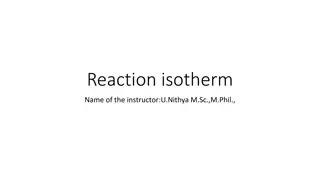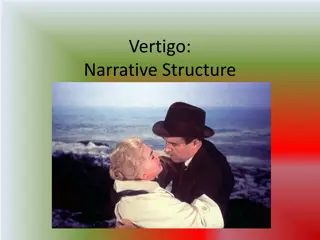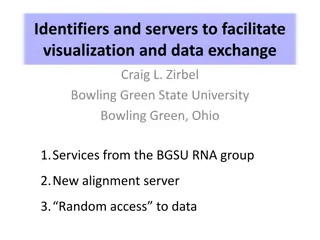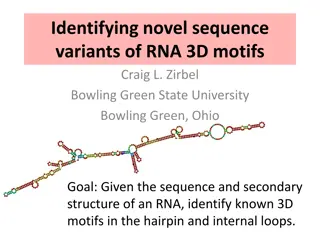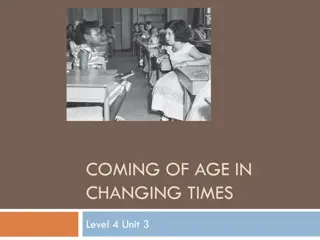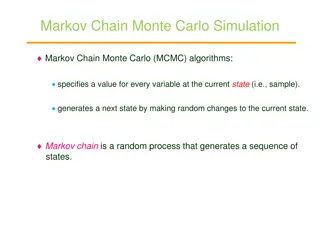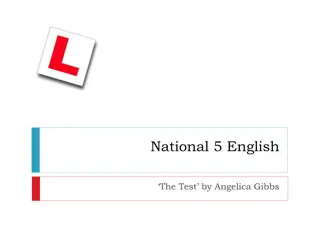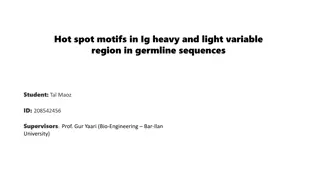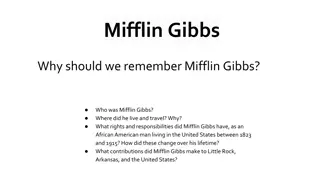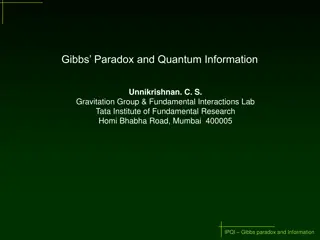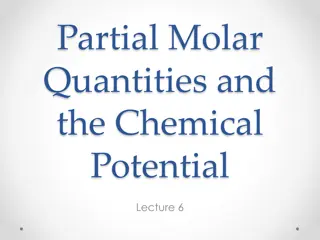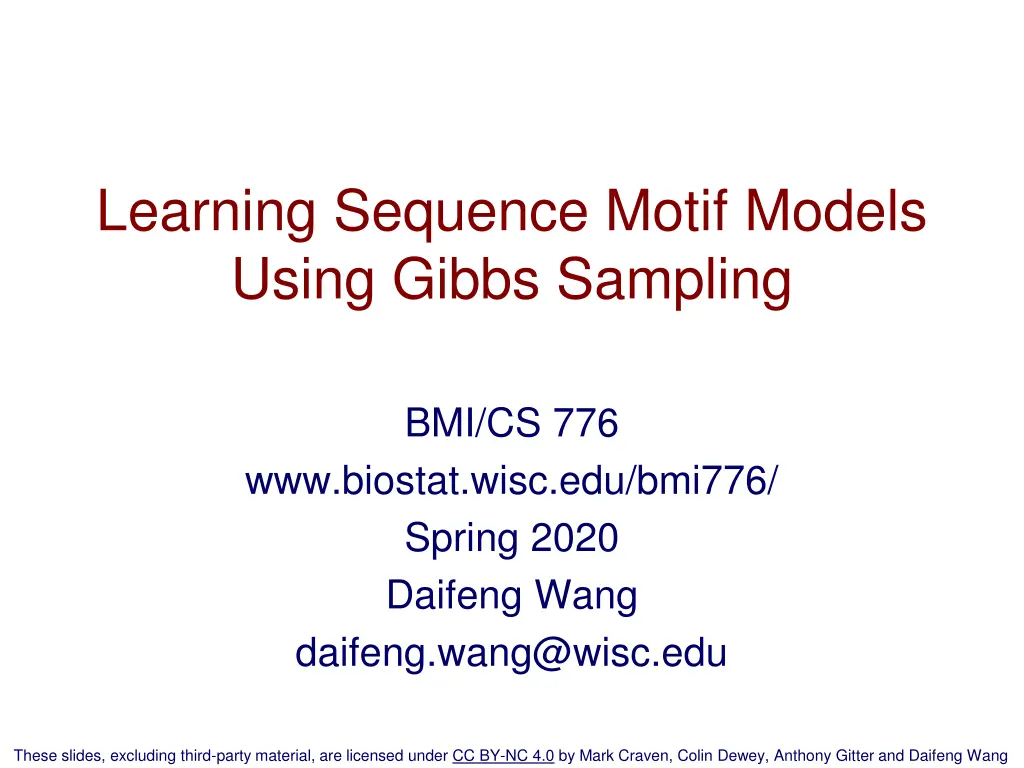
Learning Sequence Motif Models Using Gibbs Sampling
Explore the use of Gibbs sampling in learning sequence motif models, key concepts include Markov Chain Monte Carlo, parameter tying, and incorporating prior knowledge. Gibbs sampling provides an alternative to EM, offering a stochastic approach less susceptible to local maxima. Understand the Gibbs sampling approach and the principles of Markov Chain Monte Carlo.
Download Presentation

Please find below an Image/Link to download the presentation.
The content on the website is provided AS IS for your information and personal use only. It may not be sold, licensed, or shared on other websites without obtaining consent from the author. If you encounter any issues during the download, it is possible that the publisher has removed the file from their server.
You are allowed to download the files provided on this website for personal or commercial use, subject to the condition that they are used lawfully. All files are the property of their respective owners.
The content on the website is provided AS IS for your information and personal use only. It may not be sold, licensed, or shared on other websites without obtaining consent from the author.
E N D
Presentation Transcript
Learning Sequence Motif Models Using Gibbs Sampling BMI/CS 776 www.biostat.wisc.edu/bmi776/ Spring 2020 Daifeng Wang daifeng.wang@wisc.edu These slides, excluding third-party material, are licensed under CC BY-NC 4.0 by Mark Craven, Colin Dewey, Anthony Gitter and Daifeng Wang
Goals for Lecture Key concepts: Markov Chain Monte Carlo (MCMC) and Gibbs sampling CS 760 slides for background Gibbs sampling applied to the motif-finding task parameter tying incorporating prior knowledge using Dirichlets and Dirichlet mixtures 2
Gibbs Sampling: An Alternative to EM EM can get trapped in local maxima One approach to alleviate this limitation: try different (perhaps random) initial parameters Gibbs sampling exploits randomized search to a much greater degree Can view it as a stochastic analog of EM for this task In theory, Gibbs sampling is less susceptible to local maxima than EM [Lawrence et al., Science 1993] 3
Gibbs Sampling Approach ( ) t Z In the EM approach we maintained a distribution over the possible motif starting points for each sequence at iteration t i In the Gibbs sampling approach, we ll maintain a specificstarting point for each sequence but we ll keep randomly resampling these ia 4
Markov Chain Monte Carlo (MCMC) Consider a Markov chain in which, on each time step, a grasshopper randomly chooses to stay in its current state, jump one state left or jump one state right. 0.25 0.25 0.5 0.5 0.5 0.5 0.5 3 4 2 1 0.25 0.25 0.25 0.25 0.25 0.5 0.25 0.5 0.25 0.5 +1 +2 +3 +4 0.25 0.25 0.25 0.25 0.25 0.25 0.25 0.25 0.25 Figure from Koller & Friedman, Probabilistic Graphical Models, MIT Press Let P(t)(u) represent the probability of being in state u at time t in the random walk 1 ) 0 ( = P ) 1 + = ) 2 + = ) 0 ( ) 0 ( = ) 0 ( ( 0 ( 0 P P P ) 1 + = ) 2 + = ) 1 ( ) 1 ( ) 1 ( ( . 0 = 25 ( 0 P P ) 0 ( 5 . 0 = ) 1 + ) 2 + = ) 2 ( ) 2 ( ) 2 ( ( . 0 25 ( . 0 0625 P P ) 0 ( . 0 375 P ) 1 + ) 2 + 100 ( ) 100 ( ) 100 ( ) ( . 0 11 ( . 0 11 P P ) 0 ( . 0 11 P 5
The Stationary Distribution Let P(u) represent the probability of being in state u at any given time in a random walk on the chain + ) ( ) ( ) 1 t t ( ) ( ) P u ( P u (for some sufficiently large t) v + = ( ) 1 ( ) t t ( ) ( | ) P u P v u v probability of state v probability of transition v u The stationary distribution is the set of such probabilities for all states 6
Markov Chain Monte Carlo (MCMC) We can view the motif finding approach in terms of a Markov chain Each state represents a configuration of the starting positions (ai values for a set of random variables A1 An) Transitions correspond to changing selected starting positions (and hence moving to a new state) ACATCCG CGACTAC ATTGAGC CGTTGAC GAGTGAT TCGTTGG ACAGGAT TAGCTAT GCTACCG GGCCTCA state u ACATCCG CGACTAC ATTGAGC CGTTGAC GAGTGAT TCGTTGG ACAGGAT TAGCTAT GCTACCG GGCCTCA state v A1=5 A1=3 ( | ) v u 7
Sampling with MCMC Suppose we have a probability distribution ?(?) for which we would like to find the mode: argmax ? sample from But it may be intractable to do either directly Key idea: construct a Markov chain with states corresponding to configurations of ? stationary distribution equal to ?(?) Running MCMC with such a Markov chain allows us to address both tasks even when the number of configurations is generally quite large! ?(?) 8
Markov Chain Monte Carlo How do we construct a Markov chain with a stationary distribution equal to our probability distribution, P, of interest? Set the transition probabilities such that the condition of detailed balance holds for all pairs of states, u and v: ) | ( ) ( u v u P = ( ) ( | ) P v u v probability of state u When detailed balance holds, if we perform MCMC with N samples and count(u) is the number of times we are in state u, then: probability of transition u v 1 N = lim ( ) ( ) count u P u N 9
MCMC with Gibbs Sampling Gibbs sampling is a special case of MCMC in which Markov chain transitions involve changing one variable at a time Transition probability is conditional probability of the changed variable given all others We sample the joint distribution of a set of random variables by iteratively sampling from ) ... , ... | ( 1 1 1 n i i i A A A A A P + ( ... ) P A n A 1 10
Gibbs Sampling Approach Possible state transitions when first sequence is selected ACATCCG CGACTAC ATTGAGC CGTTGAC GAGTGAT TCGTTGG ACAGGAT TAGCTAT GCTACCG GGCCTCA ACATCCG CGACTAC ATTGAGC CGTTGAC GAGTGAT TCGTTGG ACAGGAT TAGCTAT GCTACCG GGCCTCA ACATCCG CGACTAC ATTGAGC CGTTGAC GAGTGAT TCGTTGG ACAGGAT TAGCTAT GCTACCG GGCCTCA ACATCCG CGACTAC ATTGAGC CGTTGAC GAGTGAT TCGTTGG ACAGGAT TAGCTAT GCTACCG GGCCTCA ACATCCG CGACTAC ATTGAGC CGTTGAC GAGTGAT TCGTTGG ACAGGAT TAGCTAT GCTACCG GGCCTCA 11
Gibbs Sampling Approach The probability of a state is given by ( ) n u , c j p W c , c j ( ) P u count of c in motif positionj p = 1 j 0 , c background probability for character c probability of c in motif positionj u ACATCCG CGACTAC ATTGAGC CGTTGAC GAGTGAT TCGTTGG ACAGGAT TAGCTAT GCTACCG GGCCTCA (u ) n 1 2 3 1 3 1 A 5 2 1 C See Liu et al., JASA, 1995 for the full derivation G 2 2 6 2 3 2 T 12
Estimating p cp, Recall represents the probability of character c in position k; values for k=0 represent the background + = , ( T G C A b k n d , , c k n c k d ( c ) k t p EM: , , + ) pseudo-counts , b k b k { , , } Gibbs sampling: ??,?+?? ? 1+??, where N is # of sequences ??,0+?? ? 1 (? ?)+??, where L is sequence length and W is motif length ??,?= ??,0= 13
Gibbs Sampling Approach How do we get the transition probabilities when we don t know what the motif looks like? 14
Sampling New Motif Positions For sampling a new motif position in sequence i Estimate p from all sequences except sequence i For each possible starting position, , compute the likelihood ratio = = ) ( j j LR Ai= j + 1 j W p + , 1 c k j k k j + 1 W = k p 0 , c k j Ai= j Randomly select a new starting position with max probability {starting k ( ) LR j ( ) LR k positions} 15
Gibbs Sampling Algorithm for Motif Finding given: length parameter W, training set of sequences choose random positions for a do pick a sequence estimate p given current motif positions a (using all sequences but ) (predictive update step) sample a new motif position for (sampling step) until convergence return: p, a X i X ia i X i 16
The Phase Shift Problem Gibbs sampler can get stuck in a local maximum that corresponds to the correct solution shifted by a few bases Solution: add a special step to shift the avalues by the same amount for all sequences Try different shift amounts and pick one in proportion to its probability score 17
Convergence of Gibbs true motif deleted from input sequences 18
Using Background Knowledge to Bias the Parameters Let s consider two ways in which background knowledge can be exploited in motif finding 1. Accounting for palindromes that are common in DNA binding sites 2. Using Dirichlet mixture priors to account for biochemical similarity of amino acids 19
Using Background Knowledge to Bias the Parameters Many DNA motifs have a palindromic pattern because they are bound by a protein homodimer: a complex consisting of two identical proteins Reversed order is an identical sequence 20 Porteus & Carroll Nature Biotechnology 2005
Representing Palindromes Parameters in probabilistic models can be tied or shared a a p p 1 , 0 , p p p 0 , 1 , W , a p W , c c c p p p 0 , 1 , W , g g g p p p 0 , 1 , W , t t t During motif search, try tying parameters according to palindromic constraint; accept if it increases likelihood ratio test (half as many parameters) 21
Updating Tied Parameters p p p 0 , 1 , W , a a a p p p 0 , 1 , W , c c c p p p 0 , 1 , W , g g g p p p 0 , 1 , W , t t t + + + n n d d 1 , , 1 , W , = a t W ) a t p p b b 1 , W , a t + + + ( ( ) n d n d 1 , 1 , W , W , b b b b 22
Including Prior Knowledge Recall that MEME and Gibbs update parameters by: + n d , , = c n ( k c d k p b , c k + ) , , b k b k Can we use background knowledge to guide our choice of pseudocounts ( dc,k)? - may not be uniformly distributed Suppose we re modeling protein sequences 23
Amino Acids Can we encode prior knowledge about amino acid properties into the motif finding process? There are classes of amino acids that share similar properties 24
Using Dirichlet Mixture Priors Prior for a single PWM column, not the entire motif Because we re estimating multinomial distributions (frequencies of amino acids at each motif position), a natural way to encode prior knowledge is using Dirichlet distributions Let s consider the Beta distribution the Dirichlet distribution mixtures of Dirichlets 25
The Beta Distribution Suppose we re taking a Bayesian approach to estimating the parameter of a weighted coin The Beta distribution provides an appropriate prior ) ( ) ( t h + = 1 1 1 ( ) h t P h t ( ) ( ) where # of imaginary heads we have seen already h t # of imaginary tails we have seen already continuous generalization of factorial function 0 1 26
The Beta Distribution Suppose now we re given a data set D in which we observe Dh heads and Dt tails + + = ( ) D D + + 1 1 D D ( | ) 1 ( ) h t P D h h t t + + ( ) ( ) D D h h t t = + + Beta ( , ) D D h h t t The posterior distribution is also Beta: we say that the set of Beta distributions is a conjugate family for binomial sampling 27
The Dirichlet Distribution For discrete variables with more than two possible values, we can use Dirichlet priors Dirichlet priors are a conjugate family for multinomial data = = i i 1 K i K = 1 1 i ( ) P i i K = i 1 ( ) If P( ) is Dirichlet( 1, . . . , K), then P( |D) is Dirichlet( 1+D1, . . . , K+DK), where Di is the # occurrences of the ith value 28
Dirichlet Distributions Probability density (shown on a simplex) of Dirichlet distributions for K=3 and various parameter vectors = = ) 2 , 2 , 6 ( ) 5 , 7 , 3 ( = = ) 4 , 3 , 2 ( ) 6 , 2 , 6 ( Image from Wikipedia, Python code adapted from Thomas Boggs 29
Mixture of Dirichlets We d like to have Dirichlet distributions characterizing amino acids that tend to be used in certain roles Brown et al. [ISMB 93] induced a set of Dirichlets from trusted protein alignments large, charged and polar polar and mostly negatively charged hydrophobic, uncharged, nonpolar etc. 30
Trusted Protein Alignments A trusted protein alignment is one in which known protein structures are used to determine which parts of the given set of sequences should be aligned 31
Using Dirichlet Mixture Priors Recall that the EM/Gibbs update the parameters by: + n d , , = c n ( k c d k p b , c k + ) , , b k b k We can set the pseudocounts using a mixture of Dirichlets: = ( ) ( c ) j j n ( | ) d P , c k k j where is the jth Dirichlet component ( j ) 32
Using Dirichlet Mixture Priors = ( ) ( c ) j j n ( | ) d P , c k k j probability of jth Dirichlet given observed counts parameter for character c in jth Dirichlet We don t have to know which Dirichlet to pick Instead, we ll hedge our bets, using the observed counts to decide how much to weight each Dirichlet See textbook section 11.5 33
Motif Finding: EM and Gibbs These methods compute local, multiple alignments Optimize the likelihood or likelihood ratio of the sequences EM converges to a local maximum Gibbs will converge to a global maximum, in the limit; in a reasonable amount of time, probably not Can take advantage of background knowledge by tying parameters Dirichlet priors There are many other methods for motif finding In practice, motif finders often fail motif signal may be weak large search space, many local minima do not consider binding context 34

